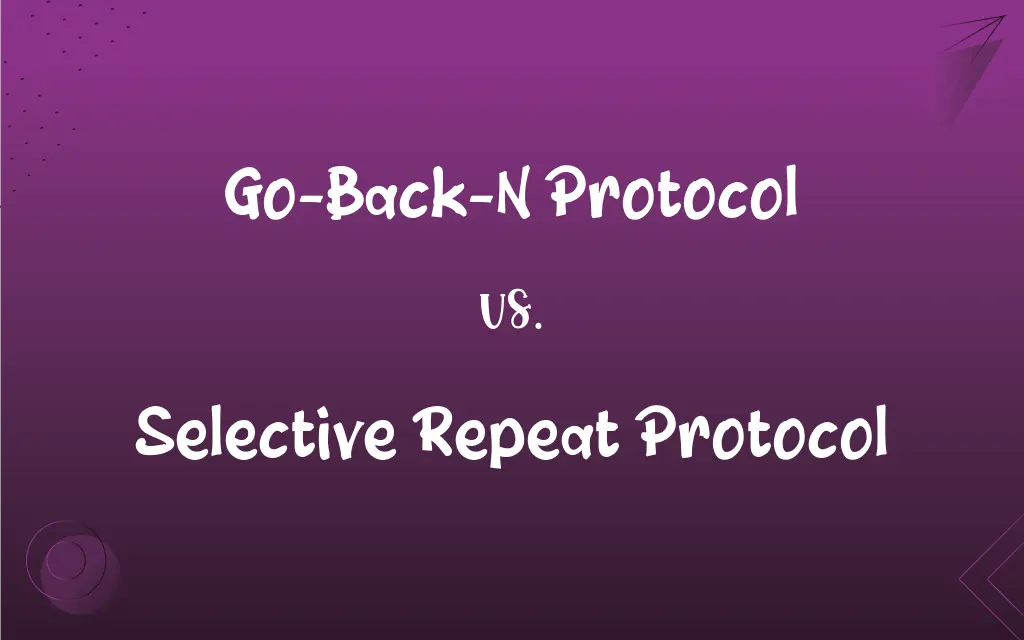Go-Back-N Protocol vs. Selective Repeat Protocol: What's the Difference?
Edited by Janet White || By Harlon Moss || Updated on October 7, 2023
Go-back-N protocol resends all packets after a lost one, while selective repeat protocol only resends the specific lost packet, ensuring efficient data transmission in each context.

Key Differences
In data communication, the go-back-n protocol is a prevalent strategy used to manage the sending of data packets over a network, wherein a sequence of packets is sent and only acknowledged once the receiver gets all of them in a predetermined window size. In contrast, the selective repeat protocol operates with the finesse of acknowledging each packet individually and only resending those that fail to be received or are erroneous. Both the go-back-n protocol and the selective repeat protocol serve to ensure data integrity and reliability during transmission, but they navigate through error recovery differently.
The go-back-n protocol is characterized by its approach to deal with packet loss or error by resending not only the failed packet but all subsequent packets as well. This is done to manage the orderly reception and processing of packets. On the flip side, the selective repeat protocol exercises a more tailored approach by identifying and resending only the specific packet that was lost or corrupted. The go-back-n protocol might be perceived as wasteful in bandwidth, while the selective repeat protocol is often seen as more efficient in that aspect, as it mitigates unnecessary resends.
When considering the implementation complexity, the go-back-n protocol is generally simpler and easier to implement as it does not require complex mechanisms to track each packet individually. Contrarily, the selective repeat protocol demands a more intricate implementation due to its need to manage the acknowledgment and potential retransmission of each packet independently. Both the go-back-n protocol and the selective repeat protocol present varying degrees of complexity and efficacy depending on the specific application and network conditions.
In the context of transmission control and resource usage, the go-back-n protocol might consume more bandwidth by resending multiple packets even if only one is lost. However, the selective repeat protocol conserves bandwidth by resending only the affected packets but may utilize more computational resources to manage individual packet statuses. Both go-back-n and selective repeat protocols present trade-offs between resource usage and transmission control, impacting their suitability in different network scenarios.
In terms of responsiveness to packet loss or error, the go-back-n protocol may be somewhat brusque, as it doesn’t discern between a singular packet error and multiple ones in its response. In comparison, the selective repeat protocol provides a more nuanced response, adapting precisely to the specific packets that are lost or erroneous. Both the go-back-n and selective repeat protocols aspire to ensure smooth and accurate data transmission, albeit with different strategies in managing packet loss or errors.
ADVERTISEMENT
Comparison Chart
Packet Resend Policy
Resends all packets after a lost one
Resends only the specific lost packet
Efficiency
Can be less efficient in bandwidth usage
Generally more bandwidth-efficient
Implementation Complexity
Simpler to implement
Requires more complex mechanisms
Resource Usage
May consume more bandwidth
Can utilize more computational resources
Responsiveness to Errors
May resend more packets than necessary
Adapts and responds to specific packet errors
ADVERTISEMENT
Go-Back-N Protocol and Selective Repeat Protocol Definitions
Go-Back-N Protocol
Go-Back-N Protocol sends a series of packets and waits for acknowledgment.
When packet loss occurs, the go-back-n protocol retransmits from the lost packet onward.
Selective Repeat Protocol
It utilizes a selective acknowledgment strategy for precision.
By acknowledging received packets, the selective repeat protocol ensures accurate data delivery.
Go-Back-N Protocol
Go-Back-N can be bandwidth-inefficient due to multiple packet resends.
The go-back-n protocol may consume excess bandwidth when errors occur due to its approach to packet retransmission.
Selective Repeat Protocol
Only erroneous or lost packets are resent, saving bandwidth.
The selective repeat protocol preserves bandwidth by limiting unnecessary packet resends.
Go-Back-N Protocol
It employs a sliding window for controlling the packet flow.
The go-back-n protocol uses its window size to manage how many packets are sent before waiting for acknowledgment.
Selective Repeat Protocol
Selective Repeat Protocol acknowledges and manages each packet individually.
The selective repeat protocol retransmits only the specific packets that are lost or corrupted.
Go-Back-N Protocol
It resends subsequent packets after a lost packet, not just the lost one.
With the go-back-n protocol, even one lost packet triggers the resend of all following packets within the window.
Selective Repeat Protocol
Selective Repeat demands intricate mechanisms for individual packet management.
Ensuring accurate transmission, the selective repeat protocol employs detailed tracking and control mechanisms.
Go-Back-N Protocol
Go-Back-N ensures data integrity with extensive error recovery.
Reliable data transmission is achieved with the go-back-n protocol through its comprehensive error handling mechanism.
Selective Repeat Protocol
It adapts and responds to each specific packet error distinctly.
Precise error handling in the selective repeat protocol enhances transmission reliability without redundant resends.
FAQs
What is the primary function of the Go-Back-N protocol?
Go-Back-N protocol ensures data integrity by retransmitting packets from the point of error if packet loss occurs.
How does Selective Repeat protocol differ in managing packet loss?
Selective Repeat protocol only resends the specific packet that was lost or errored, preventing unnecessary data transmission.
Can the Selective Repeat protocol handle high error rates efficiently?
Yes, Selective Repeat is adept at managing high error rates by specifically targeting and retransmitting only errored packets.
How does packet ordering affect the functionality of Selective Repeat?
Selective Repeat meticulously manages packet order by using individual acknowledgments and retransmitting only when necessary.
How does window size affect the functioning of the Go-Back-N protocol?
In Go-Back-N, the window size dictates how many packets can be sent before an acknowledgment is required, affecting flow control.
How does the Selective Repeat protocol manage packet acknowledgments?
Selective Repeat acknowledges each packet individually, ensuring precise error and flow control in transmission.
How does the window size in Go-Back-N impact data transmission reliability?
Window size in Go-Back-N affects how many packets are sent before receiving acknowledgment, influencing throughput and reliability.
Which protocol is generally considered more bandwidth-efficient?
The Selective Repeat protocol is often deemed more bandwidth-efficient as it selectively resends only lost or errored packets.
Are there limitations to the Go-Back-N protocol in terms of data transmission speed?
Yes, Go-Back-N may encounter limitations in scenarios with high error rates as multiple packet retransmissions can slow data transmission.
How do these protocols ensure data is received in the correct order?
Both protocols use sequence numbers to ensure ordered receipt and processing, although they manage packet errors and resends differently.
Can the Go-Back-N protocol work effectively in networks with variable latency?
Go-Back-N can be less effective in such environments due to its all-or-nothing retransmission approach, which might be bandwidth-intensive.
In what scenarios is the Go-Back-N protocol typically deemed suitable?
Go-Back-N is often suitable for environments with lower error rates due to its less complex and somewhat bandwidth-intensive nature.
Does Go-Back-N protocol require substantial computational resources?
No, Go-Back-N is less computationally intensive due to its straightforward error management and packet flow strategies.
How does Selective Repeat ensure all packets are transmitted successfully?
It meticulously tracks each packet with individual acknowledgments and retransmits only those that are lost or errored, ensuring successful transmission.
Can both Go-Back-N and Selective Repeat be utilized within the same network?
While technically possible, using both in the same network might require intricate management to navigate their differing error handling and flow control mechanisms.
In what types of networks is Go-Back-N primarily used?
Go-Back-N is frequently utilized in networks where simplicity and ease of implementation are prioritized, often where error rates are lower.
Is the Selective Repeat protocol complex to implement?
Yes, due to its precise packet tracking and selective retransmission, Selective Repeat is complex and computationally intensive.
What happens when a packet error occurs in the Go-Back-N protocol?
Go-Back-N resends all packets from the point of error, potentially retransmitting correctly received packets to ensure data integrity.
Is Selective Repeat apt for real-time data transmission?
Selective Repeat can be apt for real-time transmissions due to its efficient handling of packet loss without unnecessary retransmissions.
Is there a scenario where the Selective Repeat protocol might not be optimal?
In environments where computational resource conservation is crucial, Selective Repeat might be suboptimal due to its complexity.
About Author
Written by
Harlon MossHarlon is a seasoned quality moderator and accomplished content writer for Difference Wiki. An alumnus of the prestigious University of California, he earned his degree in Computer Science. Leveraging his academic background, Harlon brings a meticulous and informed perspective to his work, ensuring content accuracy and excellence.
Edited by
Janet WhiteJanet White has been an esteemed writer and blogger for Difference Wiki. Holding a Master's degree in Science and Medical Journalism from the prestigious Boston University, she has consistently demonstrated her expertise and passion for her field. When she's not immersed in her work, Janet relishes her time exercising, delving into a good book, and cherishing moments with friends and family.































































